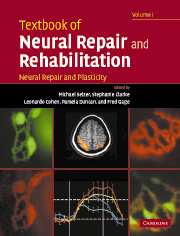Book contents
- Frontmatter
- Contents
- Contents (contents of Volume II)
- Preface
- Contributors (contributors of Volume I)
- Contributors (contributors of Volume II)
- Neural repair and rehabilitation: an introduction
- Section A Neural plasticity
- Section A1 Cellular and molecular mechanisms of neural plasticity
- Section A2 Functional plasticity in CNS system
- Section A3 Plasticity after injury to the CNS
- Section B1 Neural repair
- 16 Neuronal death and rescue: neurotrophic factors and anti-apoptotic mechanisms
- 17 Axon degeneration and rescue
- 18 Adult neurogenesis and neural precursors, progenitors, and stem cells in the adult CNS
- 19 Axon guidance during development and regeneration
- 20 Synaptogenesis
- Section B2 Determinants of regeneration in the injured nervous system
- Section B3 Promotion of regeneration in the injured nervous system
- Section B4 Translational research: application to human neural injury
- Index
16 - Neuronal death and rescue: neurotrophic factors and anti-apoptotic mechanisms
from Section B1 - Neural repair
Published online by Cambridge University Press: 05 March 2012
- Frontmatter
- Contents
- Contents (contents of Volume II)
- Preface
- Contributors (contributors of Volume I)
- Contributors (contributors of Volume II)
- Neural repair and rehabilitation: an introduction
- Section A Neural plasticity
- Section A1 Cellular and molecular mechanisms of neural plasticity
- Section A2 Functional plasticity in CNS system
- Section A3 Plasticity after injury to the CNS
- Section B1 Neural repair
- 16 Neuronal death and rescue: neurotrophic factors and anti-apoptotic mechanisms
- 17 Axon degeneration and rescue
- 18 Adult neurogenesis and neural precursors, progenitors, and stem cells in the adult CNS
- 19 Axon guidance during development and regeneration
- 20 Synaptogenesis
- Section B2 Determinants of regeneration in the injured nervous system
- Section B3 Promotion of regeneration in the injured nervous system
- Section B4 Translational research: application to human neural injury
- Index
Summary
Introduction
Developmental cell death
One of the most counter-intuitive events during the normal development of the nervous system is the massive loss of neurons that characterizes virtually all populations in the central and peripheral nervous system (CNS and PNS) (Oppenheim, 1991; Pettmann and Henderson, 1998; Oppenheim and Johnson, 2003); counter-intuitive, because as a general rule, development is a progressive process whereby new cells, tissues and organs are gradually built-up over time, whereas cell death is a prototypical regressive process. Although precise numbers are not available, as adults we are in the seemingly unenviable position of having many fewer nerve cells (several millions less!) than were present during fetal and early postnatal development. Since most of this loss occurs prior to birth, it cannot be attributed to aging, pathology or other life history events such as puberty, although, as we discuss below, pathologic neuronal loss by contrast can occur at virtually any stage in the life cycle. Rather, the developmental cell death we refer to is an entirely normal event in most tissues (Raff, 1992). In fact, the perturbation of this normal developmental cell death (i.e., too little or too much cell loss) may be a major factor in the generation of many developmental defects (Ikonomidou et al., 2001; Oppenheim and Johnson, 2003). Accordingly, it is now generally accepted that developmental cell death is a fundamental and integral part of the many adaptive strategies employed during ontogeny for generating the mature nervous system.
Keywords
- Type
- Chapter
- Information
- Textbook of Neural Repair and Rehabilitation , pp. 271 - 292Publisher: Cambridge University PressPrint publication year: 2006
- 3
- Cited by

